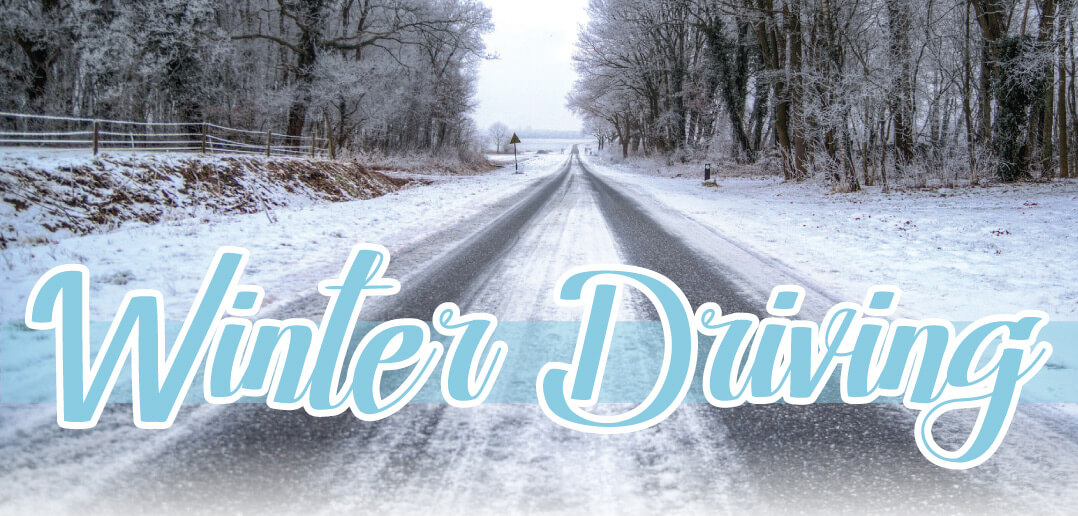Winter Driving in Lincoln, NE – 2017
Brace yourselves Lincolnites, winter is coming. (Sorry Game of Thrones fans, the actual season we have to experience here in Nebraska. You’ll still have to wait what seems like an eternity for the final season of the show.) While we fared quite well last year with mild temperatures for the most part and only a few incidences of poor driving conditions related to inclement weather, that is not anticipated to be the case this time around as we approach yet another formidable Nebraska winter. Be that as it may, we’re not strangers to it and fully appreciate the fact that it’s always wise to be prepared. To that end, the local professionals in the automotive industry are more than ready, willing, and able to help, and have offered some important things to keep in mind as we approach the inevitable.
Being the part of your vehicle that touches the road itself and is central to safe navigation of it, tires are at the top of the list.
“A key component to safe winter driving is to ensure the safety of your tires,” advises Dan Kester with Big Red Tire Pros. “With a new set of tires, you are stopping faster and shorter than you are on a set of worn-out tires. A few feet can be the difference between being in an accident and stopping. The tires on an automobile are very important, and that’s not to be underestimated. When tire tread depth falls below 5/32, the tire’s winter performance is poor, causing poor traction and difficulty stopping. If they appear choppy or have uneven wear, there could be many causes including improper inflation, improper rotation, poor alignment, or poor shocks or struts; or they may be simply worn out.
It’s important to take a close look at your tires before winter and check their overall condition. Some vehicles are best equipped during winter with either all-season tires or snow tires. While you’re checking the tires, also take a look at brakes and suspension. With icy and wet roads, it’s important to make sure your brakes are in good working condition. Check over wiper blades and coolant levels and test your battery. Batteries tend to fail in the winter time from the heat they have been exposed to in the summer.
Potholes and other road hazards are common and frequent in the winter months. If you’ve hit a pothole or ran into a curb, take a hard and close look at your tires. We see many customers who have not only had tire problems with these minor incidents, but alignment and suspension problems as well. Just as you think of changing your oil regularly, it’s important to rotate your tires every 5,000 miles for safe, even wear and check your tire’s overall wear and air pressure. Check your tire pressure frequently. In the winter months, tire pressure decreases because of colder temperature. Be sure to inflate tires to the recommended PSI found on the placard on the driver door.
This winter, be prepared and plan ahead. Check to make sure you have everything you need if you get stranded: jumper cables, tire pressure gauge, ice scraper, blanket, gloves and a small shovel. One new handy thing to add to your Christmas list is a portable power bank charger battery. For about $70 you can not only jump-start your car, but you can charge your phone or other devices and it includes an emergency LED light.”
Nick Vuko with Walker Tire and Quick Nick’s Service Centers also notes, “I always caution folks to not be fooled by the ‘All Season’ tire designation, especially this time of year. With a name like that it’s easy to have a false sense of security that it means you’ll be safe in all conditions, but that’s not the case. All Season tires are not designed for ice, snow, and slush. Instead, we highly recommend All Weather tires such as those made by Nokian, a company that is well-known worldwide for engineering tires that are the safest in inclement weather.
There are still a lot of people who have a preset idea and are sold on the concept and hesitant to change their position on it. However, I urge you to stop in and ask us questions before you absolutely make up your mind. The major safety issue with All Season tires is that stopping and turning are both a problem. With All Weather Nokian tires, you can go wherever you want and do whatever you need to do no matter what Mother Nature throws your way. Stop into any of our stores and we’ll show you exactly what we’re talking about – Nokian tires truly are the safest application of any tire we’ve ever sold in our 66 years in business.”
All told, “Giving yourself adequate stopping time and ensuring your tires have enough tread to provide ample traction will greatly help in avoiding the fender benders that commonly occur when the roads are icy and slick,” adds Dan Pape with Midtown Body & Paint. “It also helps in avoiding sliding into curbs or even off the road into mailboxes, poles, or other stationary objects. This causes damage to not only to the body of the vehicle, generally on the fender, but can also damage the tire, impacting the alignment and suspension and causing even more damage when driven afterward. Every situation is different when there’s a collision, and there can potentially be damage that isn’t visible or apparent until later on down the line, so it’s beneficial to have your vehicle checked out as a result just to be on the safe side.
He adds, “When preparing for winter road conditions and also when you’re out driving in it, all of the small things make a big difference. Pay attention, take your time, and avoid tailgating. Saving just a few minutes on the trip is hardly worth getting into an accident that will turn into hours of time and a considerable amount of money to fix, and perhaps a legal citation and everything that comes along with it on top of all that. Give yourself a little extra time, keep a little extra space from the car in front of you, and show respect for others on the road; we all want to get where we are going safely.
Sometimes accidents can’t be avoided, so be prepared accordingly. Keep a kit in the car with a blanket, flashlight, small shovel, kitty litter for extra traction, and cell phone charger – things that will get you out of a bind if you’re on your own or have your kids in the car. Particularly with the phone charger, check to ensure that your outlets will power it when the vehicle is off, and if that’s not the case, have a portable charger available. Also, with the brine mixture that’s used on the roads, washing your car periodically is a good idea. You might not see the difference right away, but a few years or more down the road the effects will likely be more noticeable. These are all small, simple things you can do that will make a big difference.”
In agreement as to why it’s beneficial to keep going through the car wash during the winter months, Kendra McDonald with JetSplash notes, “Winter is rough on your car. The brine mixture that is placed on the roads is very corrosive to the surface of your vehicle. Wash your car regularly during the winter, especially after snowstorms when brine is applied to the city streets. It is also important to apply a surface protectant to your vehicle’s surface areas regularly during the winter. This will act as a barrier and protect against the elements and corrosive road treatments. JetSplash recently introduced Jet Gloss, a unique surface protectant available only at our locations. Jet Gloss will protect your vehicle’s surface from the elements, providing water repellency and an astonishingly smooth and shiny surface. Finally, make sure your wipers are in good working condition and you have plenty of washer fluid. Don’t drive with buildup of ice and snow on your vehicle!”
Going back to taking your time when driving during winter weather conditions, Robert Peinado with GP Customs further advises, “A key feature we offer to help keep our clients more comfortable and safe on the road is a remote car starter. For customers living in an apartment complex, or even having to park their car outside at work, this can be a lifesaver. We can set it up so when you remote start your vehicle it kicks on your defrost automatically and helps remove the snow, frost, and ice off your glass.
In fact, one of the most popular items we sell during the holidays is our remote car starters with 2-way confirmation. This allows you to see that your car started and is running in real time. These visible confirmations can be either through a small LED remote attached to your key fob, or even through your cell phone with live vehicle updates. The coolest new addition is through a smartwatch, so you can start your vehicle with a flick of your wrist!
For the person who is always ‘on the go’ or in their vehicle a lot, heated washer fluid is another thing we offer to consider. This is great because it melts the snow and ice off your front windshield almost instantaneously! For those long road trips or across town commutes, we also have carbon fiber heated seat pads. These come with a lifetime warranty and have a high and low switch that will allow you to stay toasty warm during those cold winter drives.
He too emphasizes, “When driving under extreme or adverse conditions, give yourself a little extra time to get from point A to B. This is where a remote start can be most beneficial. Many people hop in their car and want to speed to either warm up their vehicle or get to their destination quickly so they don’t have to be in a cold car. A remote car starter can warm up your car 15-30 minutes before you leave from home or work, allowing for a more relaxed, cautious drive to your destination.
With the winter months coming up quickly, it’s always important to do a safety check on your vehicle as well. Some of the key areas to check are the tires, wiper blades, and brakes. While GP Customs specializes in vehicle electronics, we also have a full-time mechanics on staff who can assist with any of these items.”
Unfortunately, even for the safest of drivers who have taken all of the appropriate precautions, accidents still happen. As far as items to be aware of in the event of an accident, Matt Moorhead with Shelter Insurance offers the following advice:
“The main thing people want to know when they are in an ice-related accident is ‘Do I need to call the police?’ There is not a black and white answer to this question.
If there is an injury in the accident or a vehicle that is not drivable, I think that you should always call the police. Having this third party involved may result in someone getting a ticket but it will make things much easier in the long run. In certain instances like in a private parking lot, on a day with a high volume of accidents the police may not be able to respond. Other minor fender benders may not need the help of the police as long as both parties agree. In these instances, without the assistance of police involvement, the more information you can get the better. With smartphones, this is much easier than it ever was in the past. Get pictures of everything possible. Find out the owner of the car involved, the driver of the car involved, and snap a photo of a valid insurance card for the vehicle, registration document, and driver’s license so you’ll have access to that information when you need it. Then be sure to take pictures of the vehicle, including license plates, pictures of damage to both your car and other car, pictures of how cars were sitting after the accident and the orientation with respect to other visible landmarks. To be the most thorough, also get the names, phone numbers, and addresses of all parties involved, even passengers and/or witnesses. The more information you get the faster a claim can be handled.
Sometimes people forget how fast the conditions can change in Nebraska. Of course you are required to have your driver’s license, current insurance cards, current plates and so on every time you’re on the road, but when driving in the winter months, there are certain precautions to take beyond that for the onset of winter weather or emergency situations. Be prepared for the unexpected. If you are to slide off a road due to ice and you are in a rural or even urban area, you need to be prepared to be outside in the elements. You should have adequate shoes, clothes, gloves, coats etc. in the vehicle. Don’t just think of your destination, think of what you could encounter on your way there too.
The most commonly overlooked coverage is uninsured and underinsured motorist coverage. This is coverage for the insured in case he/she is to get hurt and the at-fault party either does not carry insurance at all or has inadequate coverage for the injury that you have incurred.
Many people think of price when buying insurance. It is drilled into our heads every 15 minutes on television and radio. Save money on your car insurance. This leads to many people buying coverage at the state minimums, which is $25,000 per person and $50,000 per accident liability coverage. What many don’t know is that with this amount of coverage, they also only get $25,000/$50,000 uninsured motorist as well as underinsured motorist. Long story short, if you were to have these coverages and were to get hit and injured by an uninsured motorist, the maximum benefit you would receive is $25,000 dollars. This many times will not pay for the trip to the emergency room alone.
Yes, going with higher limits will be a bit more expensive, but it is your best interest to have the highest liability limits and uninsured motorist/underinsured motorist coverage that you can afford. Talking with an experienced agent can help you avoid these shortfalls. During this conversation you’ll be presented with all of the options so that you can make an informed decision for yourself and your family, rather than just getting the cheapest insurance you can find online.”
Finally, Sherri Stock with inMOTION Auto Care provides advice as to the basic steps to take to get your vehicle ready for winter, which should be done as soon as possible they haven’t been already.
- Change Engine Oil – Going into winter with a clean filter and fresh oil will help your engine start better and help reduce internal component wear in the engine during longer warm-up periods. Our oil change service includes a free 82 point inspection that will cover all of the items below.
- Battery Test & Inspection – A weak battery may get you through the mild fall weather but could leave you stranded once temperatures start to plunge. Extra amps are needed to crank over a cold engine in cold weather. Any corrosion buildup on the terminals allows a voltage drain on the battery, making it even harder to start.
- Tire Inspection – Your tires are the only thing between you and the road. Low tire tread (4/32” or less) will have a difficult time getting traction in the snow and slush. Tires with insufficient tread may also hydroplane on wet roads. To further reinforce what’s already been stated by several other professionals, good tires are essential to safe winter driving!
- Check Engine Coolant – Coolant should be checked for freeze point and mix ratio as well as for cleanliness and contaminants. If the coolant should fail any part of the inspection, it should be serviced. Coolant should be replaced every 5 years to prevent corrosion of internal components due to acidity.
- Check Wiper Blades – 95% of driving decisions are based on what you see. Replacing worn wiper blades is an inexpensive way to ensure good vision! REMINDER: Washer solvent can freeze, so make sure you’re using a winter blend.
Taking the necessary precautions is essential to your safety on the roads when winter weather strikes. Be sure to take the advice provided by our local professionals into consideration and be safe out there everyone!








